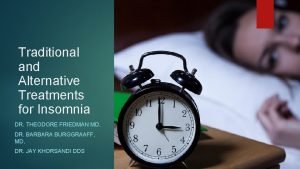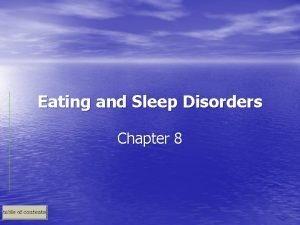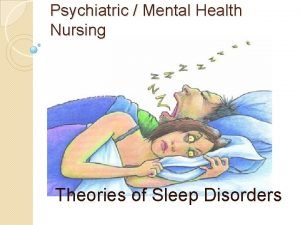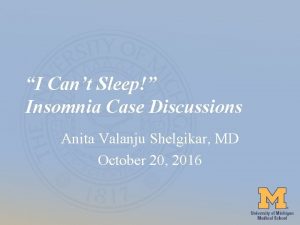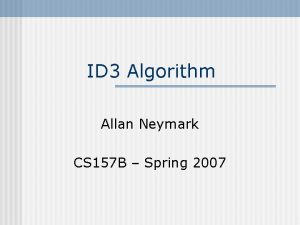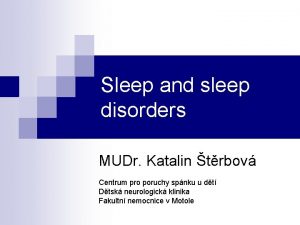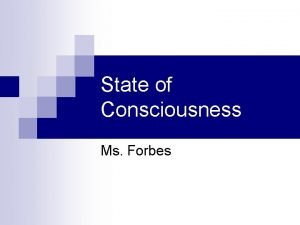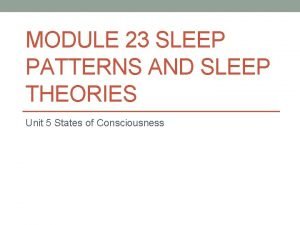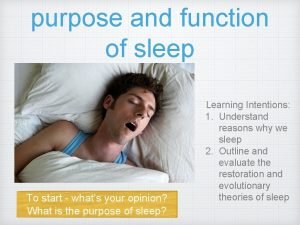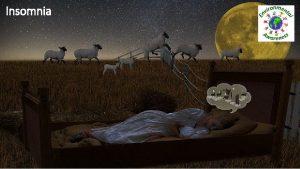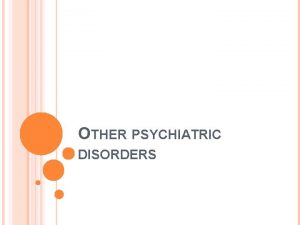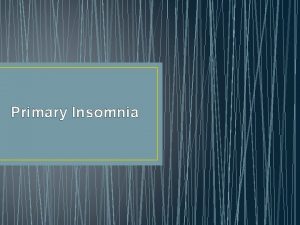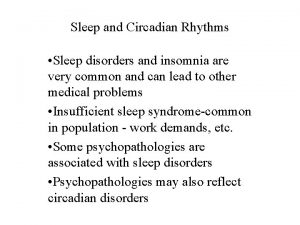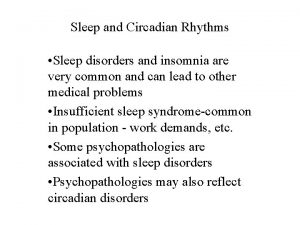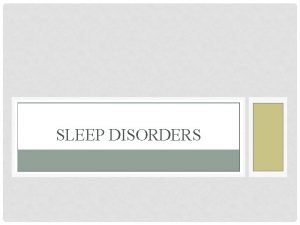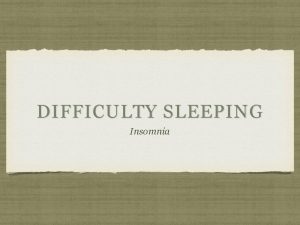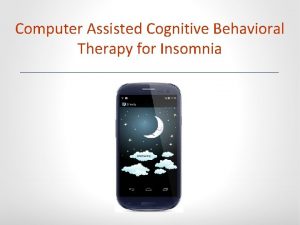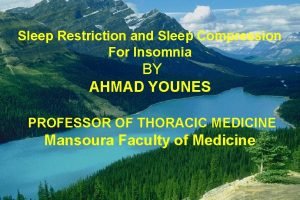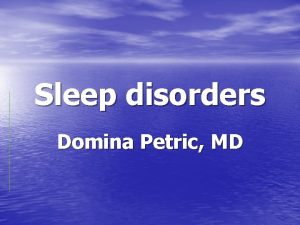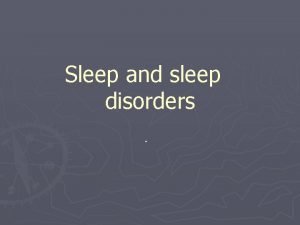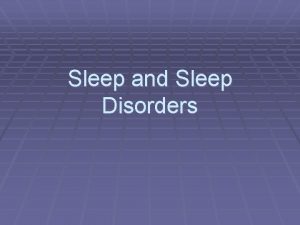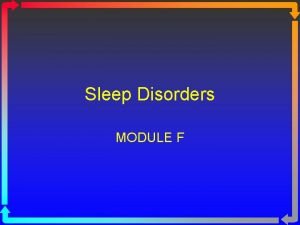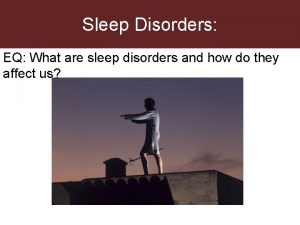SLEEP DISORDERS INSOMNIA Sleep Disorders pp 155 157





















- Slides: 21

SLEEP DISORDERS

INSOMNIA Sleep Disorders pp. 155 -157

What is Insomnia? “…is an experience of inadequate or poor quality sleep as characterized by one or more … sleep complaints. ” - National Sleep Foundation

Sleep Complaints characteristics of insomnia § Difficulty initiating sleep § Difficulty maintaining sleep § Waking too early in the morning

Types of Insomnia § Acute Insomnia § short term – due to temporary situation § Stress § change/loss in a job or relationship § jet lag § lasts up to a month § it is treatable § prescription medication can help the problem

Types of Insomnia § Chronic Insomnia § long-term – experienced for a month or more § could be caused by § medical issues § physical or psychological conditions § another sleep disorder § medications § substances (drugs) § no known cure

Facts about Insomnia § 70 million Americans are affected. § Direct costs of insomnia = $14 billion/year. § Indirect costs add up to $28 billion/year. § 58% of adults in the U. S. experience symptoms a few nights a week. § Insomnia comes from the Latin “in” = no and “somnia” = sleep

Narcolepsy Sleep Disorders pp. 155 -157

What is Narcolepsy? “… a chronic neurological disorder caused by the brain’s inability to regulate sleep-wake cycles normally. ” - National Institute of Neurological Disorders and Stroke

Characteristics of Narcolepsy § fleeting urges to sleep throughout the day § sleep may last from a few seconds to several minutes § rarely, sleep may last for an hour or more § involuntary sleep episodes § drowsiness during the daytime § frequent awakenings during nighttime sleep

Who Gets Narcolepsy? § 1 in every 2, 000 Americans § 135, 000 individuals nationally § 1 in 500, 000 in Israel § 1 in 600 in Japan § affects genders equally

What are the Symptoms? § Excessive Daytime Sleepiness § experienced by nearly all patients § typically the first noticeable sign § described as § a lack of energy § a depressed mood § extreme exhaustion § Experience involuntary sleep episodes § no more than seconds at a time

When do Symptoms Appear? § first appearance is between 10 -25 years old § can appear earlier/later in life § symptoms tend to worsen two/three decades after initial diagnosis § appearance in school-aged children § connection to childhood behaviors § attention-deficit hyperactivity disorder

Video Clip of the Week http: //www. youtube. com/watch? v=f. UTgnv. JK_hs&feature=related

Sleep Apnea Sleep Disorders pp. 155 -157

What is Sleep Apnea? “… potentially life-threatening condition that requires immediate medical attention. The risks of undiagnosed obstructive sleep apnea include heart attacks, strokes, impotence, irregular heartbeat, high blood pressure and heart disease. ” - Stanford University’s Center on Sleep Disorders

Causes of Sleep Apnea § Sleep apnea occurs when enough air cannot move into your lungs while you are sleeping § This happens when… § your throat muscles and tongue relax more than what is normal § your tonsils and adenoids are large § you are overweight § small airway size in the mouth and throat

Characteristics of Sleep Apnea § Breathing stops or becomes very shallow while you are sleeping § 10 -20 seconds or more § 20 -30 occurrences per hour Sleep Apnea - Snoring and Gasping § Insufficient amount of air flows into your lungs § amount of oxygen in your blood may drop § Normal breaths start with a loud snort or choking sound

Continuous Positive Airway Pressure • Mask is worn over your nose during sleep • Air is blown into your throat at a preset pressure level • The forced air acts to keep your throat open

Apnea Mouthpiece § Adjusts your lower jaw and your tongue to help keep your airway open while sleeping § Decreases the resistance to breathing – increases the air flow into your lungs

Facts about Sleep Apnea § More than 12 million Americans have Obstructive Sleep Apnea § Sleep apnea is more common in men § 1 in 25 middle-aged men have sleep apnea that causes them to be sleepy during the day (1 in 50 women) § Sleep Apnea is more common in African Americans, Hispanics and Pacific Islanders
 Jeff wall insomnia
Jeff wall insomnia Insomnia treatment
Insomnia treatment Insomnia scales
Insomnia scales Bulimia and insomnia
Bulimia and insomnia Remalteon
Remalteon Cbti program
Cbti program Nkb 7
Nkb 7 Tk 157
Tk 157 Surah al baqarah 154-157
Surah al baqarah 154-157 Cs 157
Cs 157 Ip 140
Ip 140 Um automóvel percorre 157 m em uma
Um automóvel percorre 157 m em uma Cs 157
Cs 157 Sleep disorders
Sleep disorders Dyssomnias
Dyssomnias Nursing management of sleep disorders
Nursing management of sleep disorders Sleep disorders
Sleep disorders Adults spend about ______% of their sleep in rem sleep.
Adults spend about ______% of their sleep in rem sleep. Module 23 sleep patterns and sleep theories
Module 23 sleep patterns and sleep theories Module 23 sleep patterns and sleep theories
Module 23 sleep patterns and sleep theories For sidney sleep is livelier than reality because
For sidney sleep is livelier than reality because Module 23 sleep patterns and sleep theories
Module 23 sleep patterns and sleep theories

